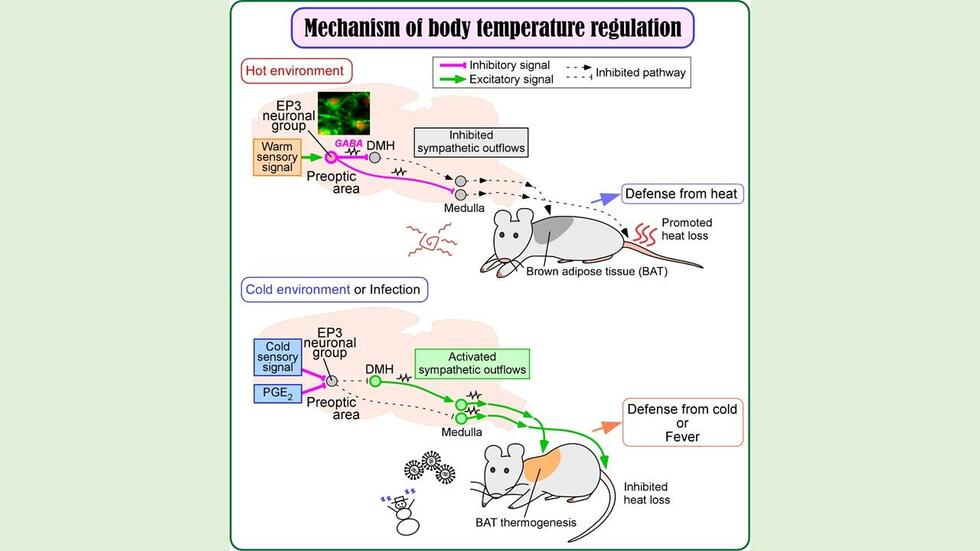
A research group at Nagoya University in Japan has reported that a group of neurons, called EP3 neurons, in the preoptic area of the brain play a key role in regulating body temperature in mammals. The finding could pave the way for the development of a technology that artificially adjusts body temperature to help treat heatstroke, hypothermia, and even obesity. The new study was published in the journal Science Advances.
Body temperature in humans and many other mammals is regulated at around 37°C (98.6°F), which optimizes all regulatory functions. When their body temperature noticeably deviates from the normal range, the functions are impaired, which could lead to heat stroke, hypothermia, and, in the worst case, death. However, these conditions might be treated if body temperature can be artificially adjusted to the normal range.
The brain’s temperature regulation center resides in the preoptic area, a part of the hypothalamus that controls the body’s vital functions. For example, when the preoptic area receives signals from a mediator called prostaglandin E (PGE2) that is produced in response to infections, this area releases a command to raise body temperature to fight against viruses, bacteria, and other disease-causing organisms.
However, it is still unclear exactly which neurons in the preoptic area release commands to increase or decrease body temperature. To identify such neurons, Professor Kazuhiro Nakamura, Lecturer Yoshiko Nakamura, and their colleagues at Nagoya University, in collaboration with Professor Hiroyuki Hioki at Juntendo University, conducted a study using rats. They focused on EP3 neurons in the preoptic area, which express EP3 receptors of PGE2, and investigated the function for regulating body temperature.
Professor Nakamura and his colleagues first investigated how the activity of EP3 neurons in the preoptic area varies in response to changes in ambient temperature. A comfortable environmental temperature for rats is around 28°C. For two hours, the researchers exposed the rats to cold (4°C), room (24°C) and hot (36°C) temperatures. Results showed that exposure to 36°C activated EP3 neurons, while exposure to 4°C and 24°C did not.
The group then observed nerve fibers of EP3 neurons in the preoptic area to identify where the signals from EP3 neurons are transmitted. The observation revealed that nerve fibers are distributed to various brain regions, particularly to the dorsomedial hypothalamus (DMH), which activates the sympathetic nervous system. Their analysis also showed that the substance that EP3 neurons use for the signal transmission to DMH is gamma-aminobutyric acid (GABA), a major inhibitor of neuronal excitation.
To further investigate the role of EP3 neurons in temperature regulation, researchers artificially manipulated their activity using a chemogenetic approach. They found that activating the neurons led to a decrease in body temperature, whereas suppressing their activity led to their increase.
Taken together, this study showed that EP3 neurons in the preoptic area play a key role in regulating body temperature by releasing GABA to send inhibitory signals to DMH neurons to control sympathetic responses. “Probably, EP3 neurons in the preoptic area can precisely regulate the signal strength to fine-tune body temperature,” said Prof. Nakamura, the lead author of the study.
“For example, in a hot environment, signals are augmented to suppress sympathetic outputs, resulting in increased blood flows in the skin to facilitate the radiation of the body’s heat to prevent heat stroke. However, in a cold environment, signals are reduced to activate sympathetic outputs, which promote heat production in brown adipose tissue and other organs to prevent hypothermia. Furthermore, at the time of infection, PGE2 acts on EP3 neurons to suppress their activity, resulting in activation of sympathetic outputs to develop fever.”
This study’s findings could pave the way for the development of a technology that artificially adjusts body temperature, which can be applied to a wide range of medical fields. Interestingly, this technology may be helpful in the treatment of obesity, by keeping body temperature slightly higher than normal to promote fat burning.
“On top of that, this technology could lead to new strategies for survival of people in hotter global environments, which are becoming a serious worldwide problem,” said Prof. Nakamura. https://www.nagoya-u.ac.jp/researchinfo/result-en/2022/12/20221226-01.html








Recent Comments